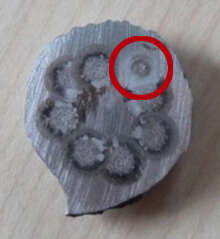Many of the world’s 50,000 foundries rely on optical emission spectrometry (OES) to give them accurate and reliable one-step quality control throughout the melting process. By providing a quick and simple way to see the exact chemical composition, instruments like the Hitachi High-Tech range of OES analyzers increase productivity and efficiency.
Keeping your spark spectrometer performing at a high level means keeping an eye out for the early signs that some maintenance might be necessary. One of the biggest indicators that your OES is not performing at the level you need it to be is the appearance of bad burn spots.
A bad burn spot is evidence that the discharge is not concentrated. A diffuse charge means that your analysis is likely to be of little use to you. There are two common types of bad burn spots that you need to look out for. If the centre of the burn has not re-melted or if the edge appears milky white, you have a bad burn on your hands and your OES needs some maintenance. It is a sign of a dip in your spark spectrometer’s performance. Unlike the results of a diffuse discharge, a good burn spot has a clearly re-melted centre and a strong black circle of deposit around it.

Put simply, bad burn spots mean that your spark spectrometer is not working in the way that it should be. This means that the analysis it is returning is unlikely to be accurate. For foundries that rely on keeping a close eye on the exact chemical composition of the products they are making, faulty analysis will quickly become costly. If you are getting bad burn spots, there are a couple of things that you should check first.
Your first port of call should be to take a look at the materials you are analysing. Specifically, if there are any inclusions, blow holes or cracks. The problem could be in the way you are preparing your samples. Accurate OES analysis requires good and careful sample preparation.
Another common cause of bad burn marks is the quality of the argon you are using or the way it is being supplied to your OES analyzer. 4.8 grade Argon is the required minimum which should be used with an OES. 5.0 grade argon or higher is the grade that should be used for spark spectrometry when you need to determine gases such as nitrogen within your material as it is very unlikely that other contaminates will be present. The amount of pressure within an argon bottle is also important to ensuring premium performance. Please refer to you argon supplier’s recommendations regarding the minimum pressure you should reach before replacing your bottle.
Your tubing
The tubing of the argon delivery system could also be to blame. Any leaks could be allowing in outside gases to contaminate the system. Obstructions in the tubing could also be stopping debris from the sample area from being cleared away properly.
Once you have checked your spark spectrometer’s set up, you should perform a number of burn samples to make sure that your analysis is back to the level you need it to be. We would recommend that you do at least three to make sure.
In our guides Non-ferrous melt control with spark OES and Cast iron melt control with OES, we go into more detail on reading burn spots. Download your copy by clicking on the links above or on the buttons below.
Guide: Melt control for non-ferrous casting Guide: Cast iron melt controlYou might also be interested in:
Our full range of spark OES instruments
View an on-demand spark OES demo
Book a 1:1 live demo